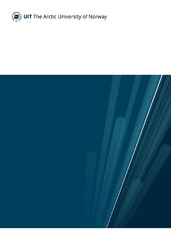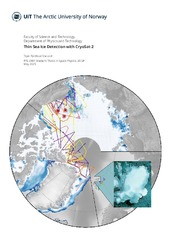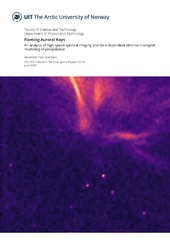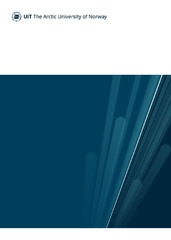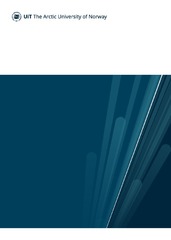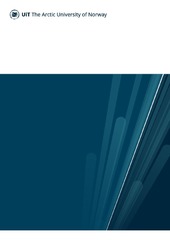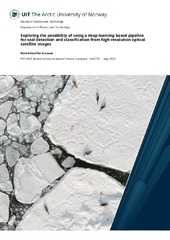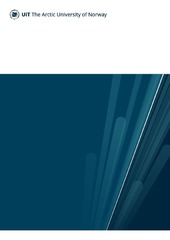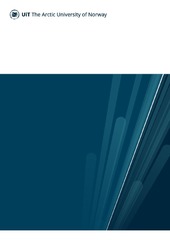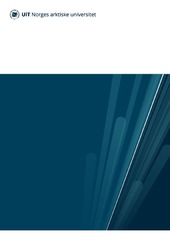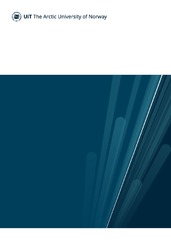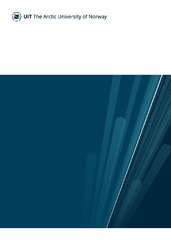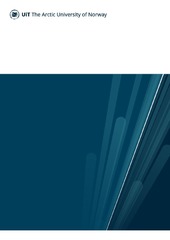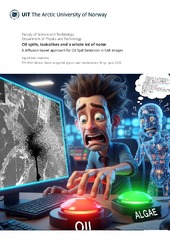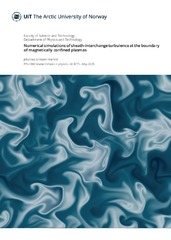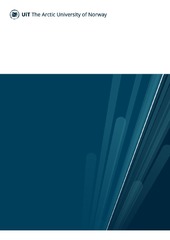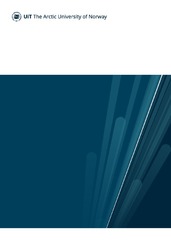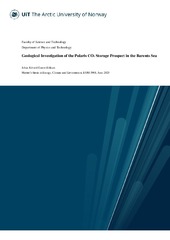Institutt for fysikk og teknologi: Recent submissions
Now showing items 1-20 of 1428
-
Uncertainty Estimation Through Test-Time Augmentation in Deep Learning for Arterial Input-Function Estimation
(Master thesis, 2025)Uncertainty estimation is an important component in the safe deployment of deep learning (DL) models, particularly in high-stakes domain such as medical imaging. While DL models often achieve impressive predictive performance, they typically provide no indication of how reliable their outputs are. In this thesis, we investigate the use of test-time augmentation (TTA) to estimate predictive uncertainty ... -
Thin Sea Ice Detection with CryoSat-2
(Master thesis, 2025)Arctic sea ice plays a vital role in the climate system, influencing atmospheric circulation, oceanic processes, and Arctic ecosystems. Thin sea ice is particularly important, as it governs seasonal transitions and contributes to feedback mechanisms such as Arctic amplification. Reliable estimates of sea ice thickness (SIT), especially within the thin ice regimes (less than 1 m), are essential for ... -
Flaming Auroral Rays - An analysis of high-speed spectral imaging and time-dependent electron-transport modelling of precipitation
(Master thesis, 2025)The current understanding of flaming auroral rays is that they are produced by short bursts of electrons precipitating down into the upper atmosphere. The altitude variation of the ionospheric response to such electron precipitation will be dependent on the energy-time dispersion of the incoming electron-bursts. The aim of this project has been to investigate the source of flaming auroral rays, ... -
Feasibility Study of Space-Based Techniques for Measuring Millimeter-Scale Orbital Debris Flux
(Master thesis, 2025)The increasing density of space debris poses a growing threat to satellite operations and future missions. While sub-millimeter debris is studied through impact craters and objects larger than 0.5 cm are tracked by ground-based radar, debris in the 1–3.2 mm range remains largely unmonitored. This thesis investigates the feasibility of using space-based techniques to estimate the flux of millimeter-scale ... -
Modelling of Snow Particle Settling Dynamics in Boundary Layer Turbulence: Evaluating Maxey-Riley and Reduced-Order Models with Nonlinear Drag
(Master thesis, 2025)Accurately modelling snow particle settling dynamics in the atmospheric boundary layer remains a fundamental challenge. These dynamics influence snowfall transport and ground snow accumulation which in turn impact hydrology, weather predictions, and climate modelling. While the foundational work of Maxey and Riley (1983), which introduced equations describing inertial particles in a fluid flow, has ... -
Time-lapse seismic analysis and Synthetic Modeling of CO2 injection at the Snøhvit storage site in the SW Barents Sea
(Master thesis, 2025)Given substantial emissions of greenhouse gases, carbon capture and storage (CCS) plays an increasingly important role in efforts to reduce emissions. The Snøhvit CO2 injection project began in 2008 with injection into the Tubåen Formation through well F-2 H, which due to rapid pressure build-up was terminated in 2011 and moved to the shallower Stø Formation. A second injection well G-4H was drilled ... -
Polar Weather Modelling with Graph Neural Networks
(Master thesis, 2025)Accurately predicting wind speed is essential for assessing the viability of new offshore wind farm locations. However, forecasting wind patterns in regions such as the Norwegian Arctic presents significant challenges due to complex terrain and variable atmospheric conditions. Graph Neural Networks (GNNs), which are well-suited for learning from spatially structured and interconnected data, offer a ... -
Exploring the possibility of using a deep learning based pipeline for seal detection and classification from high-resolution optical satellite images
(Master thesis, 2025)In this thesis, we investigate the possibility of using a deep learning based pipeline for detection and classification of seals in high-resolution optical satellite images. The pipeline includes a seal detector which uses a UNet-3+ architecture and a clustering module for point level prediction, and an image level convolutional neural network (CNN) seal classifier. Areal images targeting the seal ... -
Reliable reduction of manual workload for oil spill detection in SAR images using uncertainty estimation and deep learning
(Master thesis, 2025)Marine oil spills require constant monitoring as they can cause severe environmental damage. Synthetic Aperture Radar (SAR) images are often used for oil spill detection, but they are complex and the analysis is a time-consuming process as there are a lot of areas to monitor. Therefore, the manual analysis of the images will inevitably lead to some errors. Deep learning models can be deployed for ... -
Modelling ice throw trajectories from wind turbines
(Master thesis, 2025)Wind turbines in cold climates can occasionally experience ice throws that travel significant distances, posing a low-probability but high-consequence safety risk. Current guidelines typically rely on the empirical Seifert safety distance, defined as d = k x (H + D), where k is the throw factor – commonly set to 1.5, H is the hub height, and D is the rotor diameter. However, both observational field ... -
Vurdering av fleksibilitetspotensialet til smart varmtvannsberedere i Tromsø, basert på empirisk data fra innovasjonsprosjektet Smart Senja
(Master thesis, 2025)Økt elektrifisering av samfunnet har ført til høyere belastning og dermed ført til et økt behov for fleksibilitet i strømnettet. Varmtvannsberedere er et standard husholdningsapparat som finnes i de aller fleste husholdninger i Norge. Varmtvannsberedere er den vanligste formen for termisk lagring. Ved å utnytte den termiske lagringskapasiteten kan man flytte strømforbruket til lavlastperioder. Denne ... -
Mapping Reasoning Paths of Large Language Models
(Master thesis, 2025)This thesis tracks general LLM reasoning by examining how two open-weight models—GPT2-XL (1.5 B) and GPT-Neo (1.3 B)—organise meaning across their hidden layers. Four structured text suites (unrelated, related, identical, cross-lingual) and 50-word “Country-Stories” summaries feed the models. Layer-wise activations are projected with UMAP, connected via k-nearest-neighbour graphs, and summarised ... -
Using Self-Supervised Learning To Improve Deep Learning-Based Analysis of 4D PET Imaging
(Master thesis, 2025)Dynamic positron emission tomography (dPET) imaging requires an accurate arterial input function (AIF) for quantitative analysis. However, traditional methods for AIF measurement require invasive blood sampling. Recent deep learning models can predict the AIF from the 4D PET data itself, eliminating the need for invasive blood sampling. However, their performance often degrades with limited amount ... -
Sparse Neural Network Interpretability: A Comparative Analysis of Au toencoders and Transformers
(Master thesis, 2025)As neural networks grow increasingly complex and powerful, understanding their internal representations becomes critical for ensuring safe and reliable AI systems. This thesis addresses a fundamental challenge in mechanistic interpretability: how architectural choices in sparse representation learning shape our ability to understand neural network internals. We present the first comprehensive ... -
Oil spills, lookalikes and a whole lot of noise: A diffusion based approach for Oil Spill Detection in SAR Images
(Master thesis, 2025)Accurate and fast oil spill detection is crucial to enable effective usage of mitigation resources to minimize environmental damage. Synthetic Aperture Radar (SAR) imagery provides a reliable means of large-scale ocean monitoring, but analyzing these images remains a time-consuming and labor-intensive task. The presence of lookalikes in SAR images, natural phenomena imitating the appearance of oil ... -
Investigation of Polar Mesospheric Summer Echoes observed with the EISCAT VHF radar
(Master thesis, 2025)During the summer months at high and mid-latitudes, VHF and UHF radars can detect strong radar echoes, known as Polar Mesospheric Summer Echoes (PMSE), at altitudes between 80 and 90 km. The formation of PMSE is closely linked to the presence of ice particles, turbulence, and irregularities in the electron density. Current theories suggest that neutral turbulence causes the spatial structuring of ... -
Numerical simulations of sheath-interchange turbulence at the boundary of magnetically confined plasmas
(Master thesis, 2025)Controlled thermonuclear fusion holds great potential as an abundant, safe and environmentally friendly source of electrical energy. One of the most promising approach to harness fusion energy is trough the use of tokamak, a machine with a strong toroidal magnetic field. However the intrinsic curvature of the tokamak leads to an interchange instability, akin to the Rayleigh Taylor instability, in ... -
Variability of Circulation and Water Masses in Kvitøya Trough
(Master thesis, 2025)The physical environment of the northern Barents Sea is shaped by the inflow of warm, saline Atlantic Water (AW) and the seasonal cycle of sea ice. Recent years have seen a rapid shift toward more Atlantic conditions, driven by reduced sea ice import and increased influence of AW intrusions. Although seasonal variability is crucial for understanding these changes, observations from the ice-covered ... -
Comparison between high-resolution large-eddy simulation (LES) of atmospheric flows and the WindNinja wind downscaling algorithm, emphasizing Lagrangian coherent structures to enhance predictions for snow redistribution in alpine environments.
(Master thesis, 2025)Avalanche forecasters, hydrologists and winter recreationalists are asking themselves the same question: where is the snow on the mountain. Unfortunately, snow distribution is a highly complex area of research due to the turbulent behavior of atmospheric flow. The structural organization of the flow can be analyzed via Lagragian coherent structure (LCS) methods, such as finite-time Lyapunov exponents ... -
Geological Investigation of the Polaris CO₂ Storage Prospect in the Barents Sea
(Master thesis, 2025)This thesis investigates the Polaris prospect in the southwestern Barents Sea as a potential site for geological CO₂ storage. The study’s objectives were to (1) map the storage complex, (2) assess reservoir and seal suitability, (3) estimate storage capacity, and (4) evaluate leakage potential through the regional fault system. To achieve this, 3D seismic data were interpreted in Petrel alongside ...


 English
English norsk
norsk